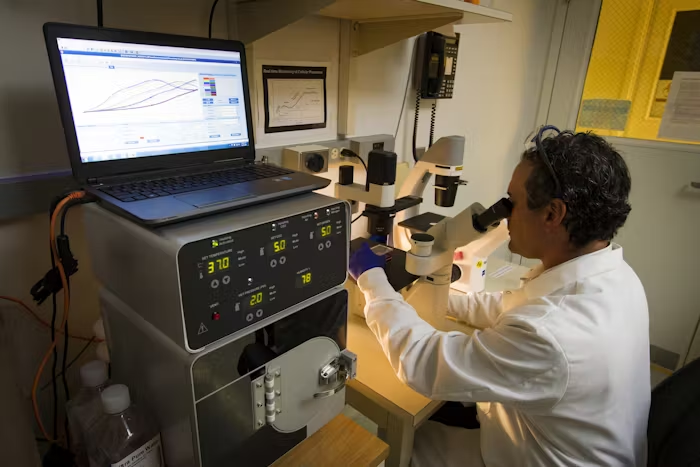Advancements in biotechnology have paved the way for groundbreaking solutions in medicine, and one of the most revolutionary tools to emerge in recent years is CRISPR-Cas9. Known for its precision and efficiency, CRISPR is a genetic editing tool with the potential to transform how we approach fighting diseases. This article delves deep into The Role of CRISPR in Fighting Diseases, exploring its mechanism, applications, ethical considerations, and the promise it holds for the future of medicine.
Understanding CRISPR: The Genetic Scissors
What is CRISPR?
CRISPR stands for Clustered Regularly Interspaced Short Palindromic Repeats, a naturally occurring system in bacteria that serves as a defense mechanism against viruses. When combined with the Cas9 protein, CRISPR functions as a precise tool to edit, delete, or modify specific genes.
How Does CRISPR Work?
- Recognition of Target DNA: Scientists design a guide RNA (gRNA) to match the DNA sequence they want to edit.
- Binding to DNA: The gRNA guides the Cas9 protein to the target DNA.
- Cutting the DNA: Cas9 acts like molecular scissors, creating a break in the DNA.
- Repair and Modification: Cells naturally repair the cut DNA, allowing scientists to insert or modify genetic material.
This ability to target genes with pinpoint accuracy is what makes CRISPR a game-changer in fighting diseases.

CRISPR’s Role in Combating Genetic Disorders
Tackling Inherited Diseases
Genetic disorders, such as cystic fibrosis, Huntington’s disease, and sickle cell anemia, result from mutations in specific genes. With CRISPR, these faulty genes can be repaired or replaced.
Example:
- In 2020, a patient with sickle cell disease underwent a CRISPR-based therapy, showing promising results in reversing the condition.
Preventing Hereditary Conditions
By editing the DNA in embryos or germline cells, CRISPR has the potential to eliminate hereditary diseases, preventing them from being passed on to future generations.
CRISPR in Fighting Infectious Diseases
Combating Viral Infections
CRISPR has shown potential in targeting viruses like HIV, herpes, and even SARS-CoV-2, the virus responsible for COVID-19. By editing the viral DNA within infected cells, CRISPR can halt the replication of viruses, offering a novel approach to treatment.
Example:
- Researchers are exploring CRISPR-based antiviral therapies that can directly attack viral genomes, providing hope for patients with chronic infections.
Revolutionizing Vaccines
CRISPR is also aiding the development of next-generation vaccines by enabling rapid identification of viral mutations and improving vaccine design.
The Role of CRISPR in Cancer Treatment
Cancer is a complex disease caused by genetic mutations. CRISPR offers multiple avenues for addressing this challenge:
Editing Cancer Cells
By targeting mutations in cancer cells, CRISPR can disable genes responsible for tumor growth and proliferation.
Example:
- CRISPR has been used to edit immune cells to recognize and attack cancer cells, a technique showing promise in immunotherapy.
Personalizing Cancer Therapy
CRISPR enables the creation of personalized cancer treatments by tailoring therapies to an individual’s unique genetic profile.
CRISPR and Neurodegenerative Diseases
Diseases like Alzheimer’s, Parkinson’s, and ALS are notoriously difficult to treat due to their complex genetic and environmental components.
Targeting Genetic Risk Factors
CRISPR can identify and modify genes associated with these conditions, potentially slowing or preventing disease progression.
Example:
- Research is underway to use CRISPR to edit the APOE4 gene, a major risk factor for Alzheimer’s disease.
The Role of CRISPR in Rare Diseases
Rare diseases often receive limited attention due to their small patient populations. CRISPR is changing this narrative by offering hope for personalized treatments.
Case Study: Progeria
Progeria, a rare genetic disorder causing premature aging, has been targeted using CRISPR to correct the mutation responsible for the condition. Animal studies have shown significant improvements, paving the way for human trials.
Ethical Considerations in Using CRISPR
While the potential of CRISPR is immense, its use raises ethical concerns that must be addressed:
1. Germline Editing
Editing germline cells could lead to unintended consequences for future generations, raising questions about the ethics of altering human DNA.
2. Access and Equity
The cost and accessibility of CRISPR-based therapies could widen the gap between socioeconomic groups, making advanced treatments available only to the wealthy.
3. Off-Target Effects
CRISPR isn’t perfect; unintended edits can occur, potentially causing harmful mutations. Ensuring the safety of this technology is crucial.
Overcoming Challenges in CRISPR Applications
To fully harness The Role of CRISPR in Fighting Diseases, scientists and policymakers must address several challenges:
Improving Precision
Ongoing research aims to minimize off-target effects and improve the accuracy of CRISPR technology.
Ensuring Regulatory Oversight
Clear guidelines and regulatory frameworks are needed to govern the ethical use of CRISPR in medicine.
Expanding Accessibility
Efforts must be made to ensure that CRISPR-based treatments are affordable and accessible to all, regardless of geographic or economic barriers.
The Future of CRISPR in Medicine
Expanding Applications
The potential of CRISPR extends beyond disease treatment. It is being explored for organ transplantation, regenerative medicine, and even extending human lifespan.
Collaborative Research
Global collaboration among scientists, institutions, and governments will accelerate the development of CRISPR-based therapies and ensure their ethical implementation.
Public Education
Educating the public about the benefits and risks of CRISPR is essential for building trust and fostering informed discussions about its use.
The Transformative Impact of CRISPR
CRISPR is not just a tool; it is a revolution in biotechnology that is reshaping our understanding of medicine and genetics. Its ability to edit genes with precision opens up new possibilities for curing diseases that were once considered untreatable.
Case Study: Leber Congenital Amaurosis
In a landmark clinical trial, CRISPR was used to treat Leber congenital amaurosis, a genetic disorder causing blindness. Early results have shown significant improvement in patients’ vision, highlighting the transformative potential of this technology.
The Role of CRISPR in Fighting Diseases is a testament to the power of innovation in transforming healthcare. From curing genetic disorders to combating infectious diseases, CRISPR is unlocking new frontiers in medicine. However, with great power comes great responsibility. Addressing ethical concerns, ensuring equitable access, and advancing research will be critical to realizing CRISPR’s full potential.
As we stand on the brink of a new era in medicine, CRISPR offers a beacon of hope for millions of patients worldwide. Its ability to precisely edit genes is not just a scientific breakthrough but a transformative force that has the potential to redefine how we approach health and disease. By embracing this revolutionary tool responsibly, we can create a future where the impossible becomes possible, and diseases that once seemed insurmountable become a thing of the past.














